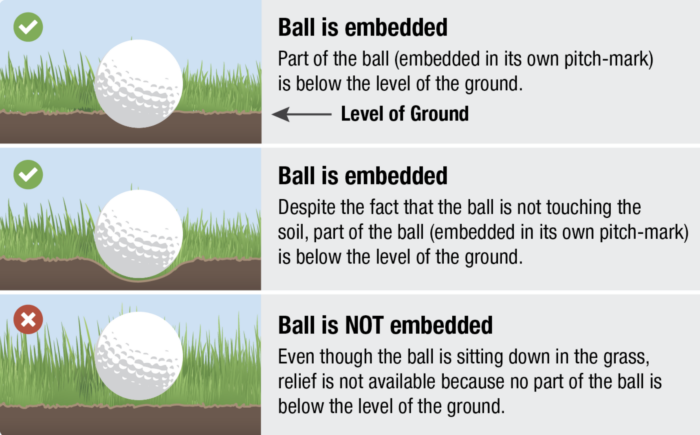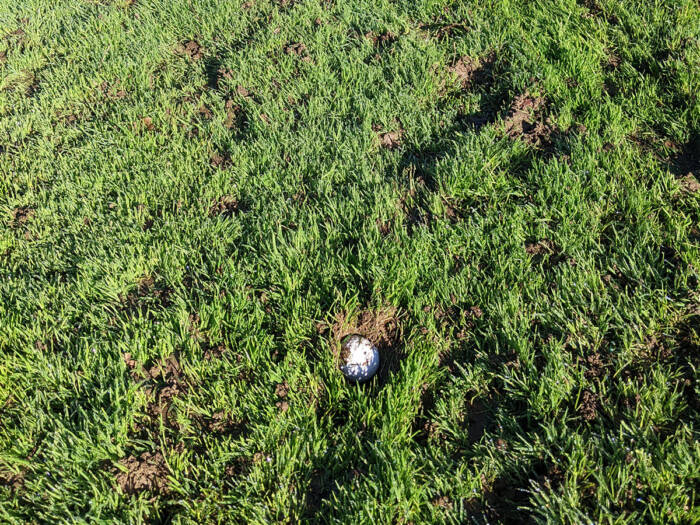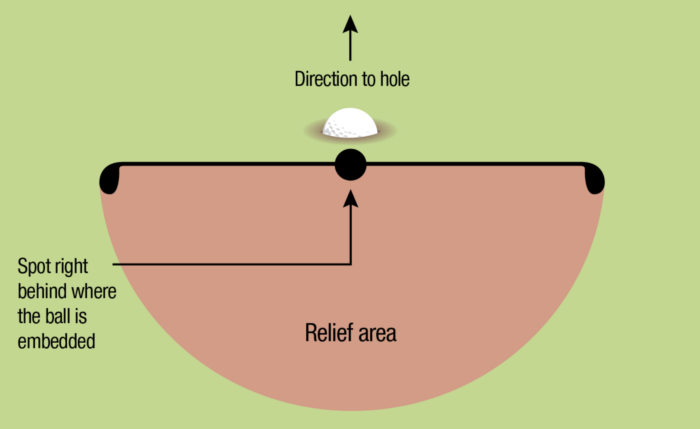Plugged Ball Rule in Golf: Everything You Need To Know
In the rules of golf, few situations can cause as much confusion as the embedded (or plugged) ball!
Having grown up in Manchester (where it rains an awful lot!) it’s something I’ve had to deal with all my golfing life.
Historically, the rule has undergone several changes, the most recent of which, in 2019, broadened the scope of relief for players across the course.
This article aims to demystify the embedded ball rule, offering a detailed exploration of its definitions, the conditions under which it applies, and the correct procedures for taking relief.
What Constitutes a Plugged Ball?

According to the Rules of Golf, a ball is considered plugged or embedded when it has come to rest in its own pitch-mark, with part of the ball below the surface level of the ground.
This situation typically occurs on soft ground, such as after heavy rainfall, where the ball has enough momentum to penetrate the ground surface.
For a ball to be officially deemed embedded, several criteria must be met:
- Location of the Ball: The ball must be in the general area of the course – a term encompassing all areas of the course except the teeing areas of the hole being played, all penalty areas, all bunkers, and the putting green of the hole being played.
- Condition of Embedment: The ball must have broken the surface of the ground upon impact, creating a pitch-mark into which it settles. Notably, the presence of grass or loose impediments between the ball and the ground does not disqualify it from being considered embedded.
- Causation: The embedment must result directly from the player’s stroke. If the ball becomes embedded after being stepped on or driven over by a cart, for instance, it does not qualify under this rule.
Understanding what constitutes an embedded ball is crucial for any golfer, as it dictates the potential for relief.
The distinction between a ball merely settled in deep grass and one that is genuinely embedded can significantly affect your next move.
Historical Context and Embedded Ball Rule Evolution
Initially, the rule was more restrictive, offering relief only in closely-mown areas “through the green,” essentially limiting it to the fairway or fringe areas around the green.
This limitation often left players at a disadvantage when their ball became embedded in the rough. The rule did not extend to these areas, meaning golfers had to play the ball as it lay or declare it unplayable with a penalty!
The 2019 amendment to the embedded ball rule, as outlined in Rule 16.3 of the Rules of Golf, significantly broadened the circumstances under which players could seek relief.
The key aspects of this change include:
- Expansion of Relief Area: Prior to the amendment, relief for an embedded ball was confined to areas cut to fairway height or lower. The revised rule allows for relief anywhere in the general area, dramatically increasing the locations on the course where players can take advantage of this rule.
(The general area refers to a broad category encompassing the entire course except for the teeing area of the hole being played, all penalty areas, bunkers, and the putting green of the hole being played.)
- Exception for Sand: The rule explicitly excludes relief for a ball embedded in sand in the general area that is not part of a bunker. This distinction is crucial, as it maintains a level of challenge and skill in navigating sandy areas while still offering relief in parts of the course where the ball may become embedded due to the softness of the ground.
- Procedure for Taking Relief: The procedure for taking relief remains thoughtful and precise. Golfers are permitted to lift and clean the ball, then drop it within one club-length of the nearest point of complete relief, no closer to the hole. This process ensures that players receive no undue advantage from taking relief, preserving the challenge of the game while offering a fair resolution to an embedded ball situation.
This change aimed to simplify the rule for players and officials alike, ensuring that relief was available regardless of where the ball became embedded, with the notable exception of sand not in a bunker.
How to Proceed with a Plugged Ball
When faced with an embedded ball on the course, the rules provide a clear and fair method for players to proceed.
Understanding the correct steps not only ensures compliance with the rules but also helps maintain the pace of play. Here’s what you should do:
1. Verify the Ball is Plugged

Firstly, the player needs to determine if the ball is indeed embedded. As already discussed, it needs to be its own pitch-mark in the general area, with part of the ball below the surface level of the ground.
You’re allowed to lift the ball to check its condition. But it’s crucial to mark the ball’s position first to ensure it can be replaced accurately if it’s not embedded.
2. Determine the Relief Area

If the ball is embedded, the player is entitled to relief. Identifying the nearest point of complete relief is the next step.
This is the spot closest to where the ball lay but not nearer the hole, where the ball would no longer be embedded.
From this reference point, the player can measure out one club-length, no closer to the hole, to establish the relief area where the ball can be dropped.
3. Dropping the Ball
The player should then drop the ball from knee height within the relief area.
This ensures the ball is played fairly from a new position, alleviating the disadvantage of the original embedded situation. The ball must come to rest in the relief area; if it rolls out, the player must re-drop it.
FAQs on the Embedded Ball Rule
Below we’ve answered some of the most common questions we receive on the plugged golf ball rule.
An embedded ball is one that has landed in its own pitch mark and part of the ball is below the level of the ground. The ball must have been embedded as a direct result of the player’s stroke, not by being stepped on or moved by a golf cart.
Rule 16.3 allows for relief from an embedded ball anywhere in the general area. This includes the entire course except for the teeing area and green of the hole you’re playing, and any penalty areas or bunkers. However, there’s an exception for balls embedded in sand in the general area that’s not in a bunker.
If your ball is embedded, you’re allowed to mark and lift the ball to check its condition. If it’s confirmed embedded, you can drop it within one club length from the nearest point of relief, no closer to the hole, ensuring the dropped ball comes to rest in the relief area.
No, there is no penalty for taking relief if your ball is embedded in the general area under the conditions specified by the rule. You’re entitled to free relief, meaning you can lift, clean, and drop your ball without adding a penalty stroke to your score.
If your ball is embedded on the putting green, the rules are slightly different. You can mark and lift the ball, repair the pitch mark, and then replace the ball on its original spot. This rule ensures that the putting surface remains fair and playable for all golfers.